1.0 Introduction
Hello again! This blog is part of a sequence connected to my writing a thesis as part fulfilment of an MSc degree in Climate Change, Agriculture and Food Security at the University of Galway – see www.nuigalway.ie/ccafs for a brief overview of the course. I am researching what constitutes institutional arrangements for Non-Annex 1 countries in the context of their UNFCCC and Paris Agreement commitments. To recap, countries as part of their UNFCCC and Paris Agreement reporting requirements are expected to describe the institutional arrangements that they have established in order to carry out the climate change work they have committed to do, in two key reports that they are expected to submit. These reports are a National Communication report (NC) and a Biennial Update Report (BUR). My last two blogs focused on describing what the NC and BUR reports are all about. The BUR is going to be replaced by a Biennial Transparency Report (BTR) in 2024, to capture the Enhanced Transparency Framework set out in the Paris Agreement, article 13. This blog gives a brief overview of what the BTR is about and discusses the challenges countries will face in delivering the transparency that is envisaged! The ‘institutional arrangements’ required to make it all happen will need to be strengthened in many countries around the world.
2.0 What is the enhanced transparency framework?
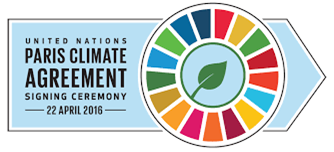
When countries (Parties) adopted the Paris Agreement in 2015, they accepted Article 13 (1) about an enhanced transparency framework for action and support being “hereby established”. But why an enhanced transparency framework? Article 13 tells us that the purpose is “to build mutual trust and confidence and to promote effective implementation”. However, article 13.3 offers some flexibility in that the framework is “to be implemented in a facilitative, non-intrusive, non-punitive manner, respectful of national sovereignty, and shall avoid placing undue burden on Parties, recognizing the special circumstances of the LDCs and SIDS”. Can that type of flexibility really be assessed? But could such flexibility be avoided? Doubtful! This is essentially a pragmatic move and a recognition that some countries will be burdened by this additional reporting. However, will transparency be threatened by this flexibility – that remains to be seen.
But greater transparency in what?
Article 13, of the Paris Agreement, paragraphs 5 and 6 set out the purpose of the enhanced transparency framework (ETF) which, in a nut shell, is a focus on clarity and the tracking of progress towards achieving (a) Parties’ ”individual nationally determined contributions “ (NDCs) under article 4; (b) Parties’ adaptation actions under article 7; and (c) Parties’ support (finance, technology and capacity development) provided or received according to articles 7, 9 and 11. It is not an easy task to provide the clarity and tracking of progress envisaged in these three areas.
Nonetheless, since 2016, when the Paris agreement came into force, efforts have been made to roll out the ETF so Parties can be ready to report on it in 2024, i.e. provide information about (a), (b) and (c).
Even if ordinary citizens are not aware of ETF, it is hoped that, if implemented, it will have a positive impact on their lives. There is a hope that many citizens globally will continue to voice the need for holding the increase in average temperature to well below 2 degrees C above pre-industrial levels, as defined in the Paris Agreement, article 2. Without clarity and tracking of progress on countries’ greenhouse gas (GHG) emissions, there is no way of ensuring whether temperatures are continuing to rise. So, if EFT promotes greater transparency in reporting, this outcome should be welcomed, despite the additional efforts that will be required to report accurately.
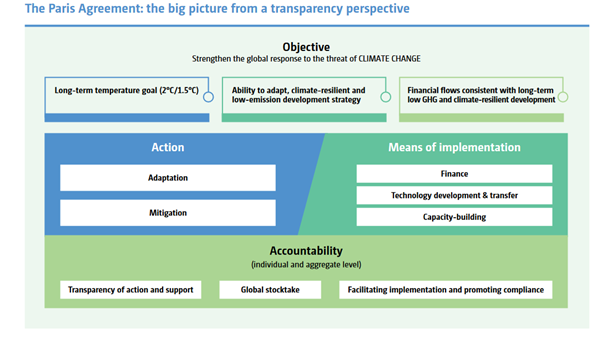
The Biennial Transparency Report (BTR), and ETF
Both Annex 11 countries and Non-Annex 12 countries have, since 2014, been submitting their Biennial Reports (BRs) and Biennial Update Reports (BURs) respectively, describing how they are addressing their climate change commitments under the UNFCCC convention (see my other blog on BRs and BURs). From 2024, these reports will be replaced with a Biennial Transparency Report (BTR), to be submitted by both Annex 1 and Non-Annex 1 countries to reflect the influence of the ETF as envisaged in the Paris Agreement.
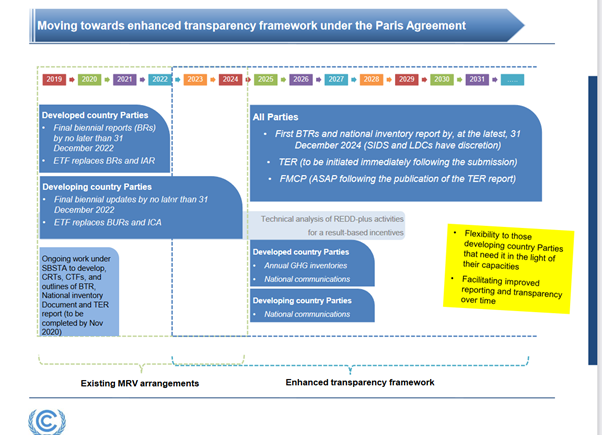
You may have noticed in the BUR guidelines that Non- Annex 1 have far fewer “shall” actions (which are mandatory) than Annex 1 countries on which to report. Non–Annex 1 countries have much more of “may”, ”should” or “encouraged”, according to countries’ abilities. However, the new ETF moves all countries towards reporting under a common set of Modalities, Procedures and Guidelines (MPGs), so now there is less of “may” or “encourage”, in favour of “shall”. Correspondingly, there is less of the phrase “Annex I or Non-Annex 1 countries”, in favour of “each party”. There is, however, some flexibility (as stated above) for developing counties, especially Least Developed Countries (LDCs) and Small Island States, (SIDs), according to their capacities. The transparency that is required in the BTR is a notch above what is currently required in in BURs and BRs.
3.0 Data,Transparency and the BTRs
‘Data, data, data’, as the saying goes, is central to transparency. Likewise, data, data, data, will be the liquid that will bind the BTR component cake mix together. Just this time, the ingredients are more elaborate and yet we do not want the cake to flop in the oven! So, do we change the oven, the ingredients or, instead, get to know more about the ingredients and how they react with each other, so the cake is better guaranteed to rise and become more nutritious! But where do we get more information on the ingredients and their makeup and how do we know what is the ideal mix? This is where support is needed. The first support is to know and understand your ingredients so that you can describe them in the BTR. To help countries, the Conference of Parties (COP) approved a set of Modalities, Procedures and Guidelines (MPGs) see decision 18/CMA. In addition, guidelines to operationalize the MPGs were developed, see decision 5/CMA.3.
But are these guidelines enough? No. We need to look at the Measurement, Reporting and Verification (MRV) system that many countries have established, related to climate change, as this system is where the data are collected and shared, analysed and verified, and reported and stored. Many countries are reviewing their MRV systems and refining and strengthening them to meet the additional information requirements for BTR.
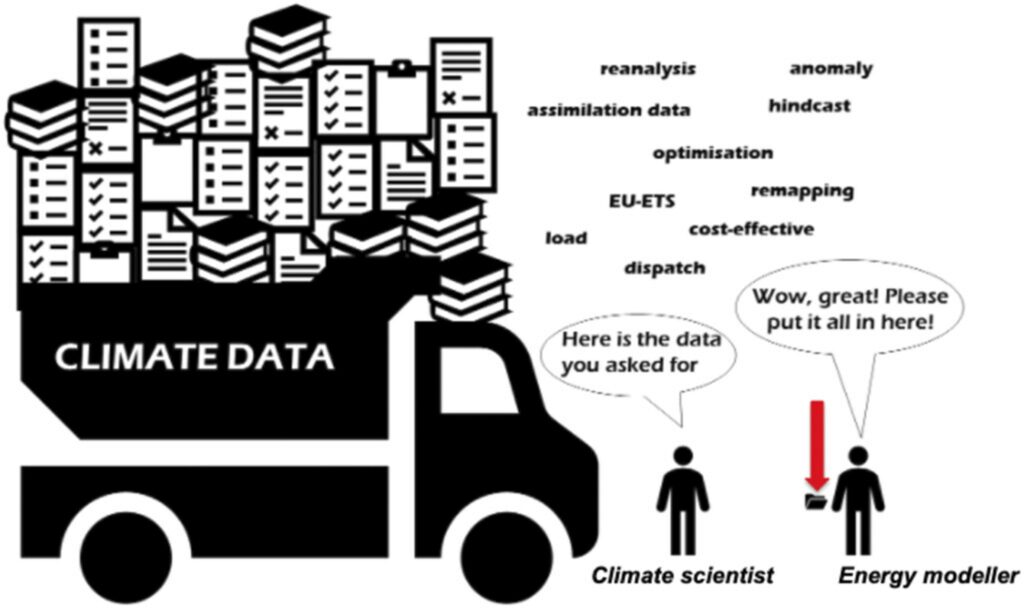
Source: https://journals.ametsoc.org/view/journals/bams/102/1/BAMS-D-20-0256.1.xml
MRV systems are critical for ETF
Many developing countries are in the process of establishing their MRVs, and some are more advanced than others. UNFCCC and the Consultative Group of Experts (CGE) have provided guidance to countries to assist them in establishing MRV systems across government. See guidance. Some have received financial assistance from the Global Environmental Fund (GEF) to assist with establishing parts of the MRV systems. Establishing MRV systems is not an easy task for either developed or developing counties, as it takes time, expertise and resources, as well as technical and political commitment. Rome was not built in a day, and neither are MRV systems. Such a system needs to be well planned and involves all ministries of government and not just state institutions. State and non-state institutions all have a role to play, either in collecting data for baselines, to understand the status of each GHG, or to determine progress in reducing a GHG. These institutions also have a role to play in analysing the data once collected; for example, in defining the greenhouse gas (GHG) reduction targets that a country should achieve by 2030, 2040 and 2050. While others may have a role in sharing and reporting the data to relevant ministries within countries or externally, in the case of BR, BUR and BTR, data are to be shared with COP through the UNFCCC secretariat.
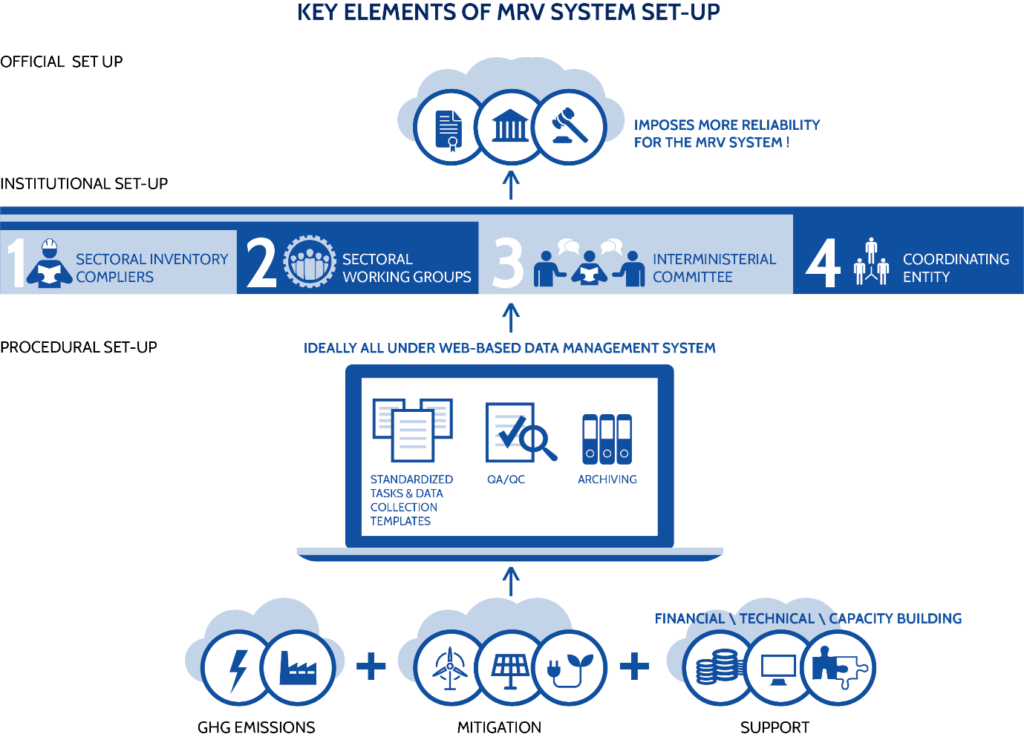
Source: https://www.mobiliseyourcity.net/mrv-ghg-africa-resource-center
4.0 Reliable data for planning, implementing and decision making
Data for Planning
So, what is involved in planning for climate change commitments? Planning, in its simplest form, is about determining where we are now (baseline/current status), where we want to go (goal/vision), and deciding the best path(s) for achieving the goal, allowing for the many environmental, social and economic considerations a country may be facing. Determining the baseline for different gaseous emissions is one of the biggest challenges facing countries today and especially for developing countries, as it involves having reliable, up-to-date data. Collecting and archiving data to define baselines for the environmental, social and economic sectors requires dedicated systems
So let us unravel what is involved in establishing a baseline in relation to the UNFCCC and the Paris agreement commitments. This process starts with collecting and analyzing data covering the types of greenhouse gas emissions in a country. But what GHG baselines does a country need to define? In brief, the key GHG emission estimates include: carbon dioxide(CO2), methane (CH4), nitrous oxide (N2O), and fluorinated gases (HFCs, PFCs and SF6), as appropriate. The National Communication (NC) report, specifically the chapter on GHG inventory, sets out in detail what gases a country is expected to report against. See my blog on National Communication (NC) report. The MRV handbook (UNFCCC 2014) also sets out in detail what countries need to include and provides links to guidance, templates and IPCC software for automated reporting. This is now updated in the MPG, in light of the EFT.
A country needs data to determine the baselines for the different GHGs and, using those data, they will then determine targets to be reached for reducing GHG emissions, and their nationally determined contribution (NDC). The amount of data required to do this analysis is enormous and the analysis is very technical, requiring complex modelling, sophisticated IT, and other technologies.
But the data for GHG reduction planning does not end there, as countries are expected to carry out a Mitigation Assessment using well recognised methodologies and to report on this in the NC as well as in their Biennial Update Report (BUR) and Biennial Report (BR). See my blog on BURs and BRs. The Mitigation Assessment typically covers the sectors of energy, Agriculture, Forestry, Land and Other Use (AFLOU), Industrial Processes and Product Use ( IPPU) and Waste. Again, from the analysis, countries are expected to report on the assessments conducted, methodologies used, and priorities identified. Again, this process requires an enormous amount of data to be collected and analysed. The findings from the Mitigation Assessment are used as the basis for countries to develop their National Appropriate Mitigation Actions (NAMAs). Once more, these assessments and plans have all to be described in detail in their NCs, BURs and BRs as well as, in the future, in BTRs. See my blog on NCs, BURs and BRs.
Remember, from the opening paragraphs above, that the purpose of the enhanced transparency framework (ETF) which, essentially, is a focus on clarity and the tracking of progress towards achieving: (a) Parties’ ”individual nationally determined contributions“ (NDCs) under article 4; (b) Parties’ adaptation actions under article 7; and (c) Parties’ support (finance, technology and capacity development) provided or received, according to articles 7, 9 and 11. Briefly, the above is about bringing clarity to (a) although the tracking part of (a) is covered below, and (b) and (c ) are also outlined below.
Countries are also expected, as part of the NC report chapter IV, to describe in detail the vulnerabilities they face. To do this, they are expected to carry out a vulnerability and assessment for adaption (V&AA) using a variety of assessment methodologies that are known globally. Again, this requires collecting relevant data and analyzing them. V&AAs are usually done for the sectors of water resources, agriculture, energy, health, biodiversity, fisheries, forest as well as for others, as relevant. Countries are also expected to share how these assessments were conducted, the models used, and the vulnerability priorities identified. These V&AA data are then used as the basis for developing National Adaptation Plans (NAPs). When NAPs are developed, countries are expected to set out clear indicators in order to track progress on the NAP actions. Again, an enormous amount of data is required for the analysis. All this V&AA and NAP information is being reported in National Communications (NCs), and in the future it will be in BTRs.
Moreover, many countries regularly conduct economic appraisals in order to guide the economy and other social assessments, all requiring the collection and analysis of data to determine the current status which will assist a country in determining the direction it wants to take. Here too, enormous amounts of data are required and the process needs to be described in the NCs, BURs, BRs and BTRs.
Furthermore, countries are expected to have in place an MRV system that includes not only all the data referred to above, but also the financial support provided or received, technologies provided and any capacity for developing training. Guidance is provided on the levels of detail required in MPGs.
Tracking Progress
Data are required not only for planning but for tracking progress, which is central to the ETF and BTRs. Henceforward, there will be greater focus not just on sharing baselines, but also on tracking progress, using reliable data. To ensure data are reliable, guidelines have been prepared by UNFCCC and countries are required to report on their adherence to these guidelines.
Tracking of progress will include tracking GHG emission programs. These programs could be mitigation or adaptation related programs. Countries are encouraged to move beyond progress reporting at the midpoint and end of projects to more continuous tracking of projects.
Data for progress indicators
The GHG emission levels will be tracked to ascertain the impact they can have on a country’s determined GHG emission reduction targets. This tracking involves defining the indicators to be tracked against the country’s individual nationally determined contributions (NDCs) for mitigation and adaptation programs – and measuring progress regularly against these indicators. Collecting data for one indicator could mean collecting data from many sources as the formula for evaluating the status of an indicator may have many variables. This process could mean reaching out to state and non-state actors to collect data for these variables, after which the data needs to be cleaned and verified. This approach needs to be taken for all agreed indicators. The data that are collected are analysed and quality assured/verified by appropriate experts. Country MRV systems need to have this quality assurance/verification expertise.
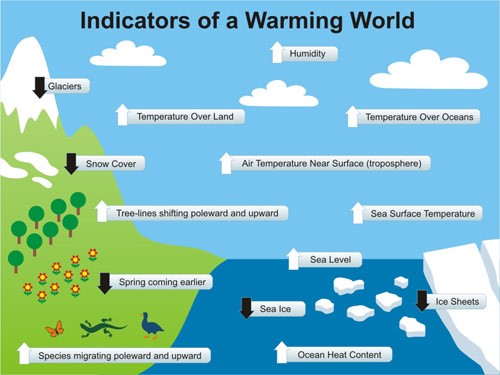
Source: https://skepticalscience.com/graphics.php?g=8
A robust MRV system is required to write BTRs as envisaged
Its clear that MRV systems require expertise at different levels a structure (preferably a permanent structure and not ad hoc), tools, methodologies and processes. Such systems also require resources to design the tools, collect and analyse the data and pay staff. Many Non-Annex 1 countries rely on external financial resources to implement many of their mitigation and adaptation programs as well as to establish their MRV systems. Many are still waiting for external resources linked to articles 9, 10 and 11 of the Paris Agreement, i.e. part (c) of the purpose of the ETF, referred to above. Hence, this situation explains why transparency is also required in reporting on articles 9, 10 and 11, i.e. on support provided and received in relation to finance, technology transfer and capacity strengthening. An MRV system should also include this type of data.
There is no doubt that all countries are expected to strengthen their MRV systems to facilitate tracking of progress for objectives (a), (b) and (c) above. Equally, there is no doubt that many developing countries, especially least developed countries (LDCs) and small island states (SIDs) will require support to establish and maintain their MRV system, so as to be able to report in their BTRs, as envisaged in Article 13 of the Paris agreement.
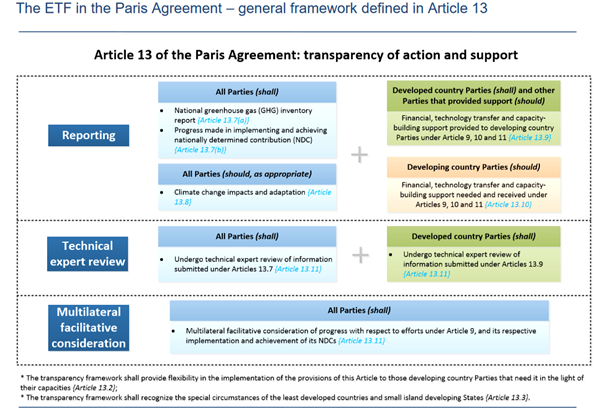
Reliable data for decision making and to help in gaining the trust of citizens
Reliable data are also required not just for planning and tracking progress in the implementation of programs, but data are critical in helping the political levels make informed decisions on proposed GHG reduction targets suggested by their technical teams. Political leaders know, if they wish to stay in power, that they will need to justify to their constituents, the GHG reduction targets agreed. They also need to be able to explain why one target may be more ambitious than another, as ultimately each target is country-specific and will have a particular impact on its citizens. Trustworthy data is to accountability as water is to life.!! More and more citizens globally are calling on their governments to be accountable for results. Therefore, there is an expectation that member states will strengthen their MRV system so that it is open and transparent, and where reliable data are not only shared with Conference of Parties, (COP) but with the public, to facilitate discussion and for holding governments to account. The BTR report is expected to trigger a need to strengthen MRV systems. It is also expected to demonstrate a country’s commitment to reducing GHGs in a fair and transparent manner. At the same time, it will contribute to knowing if the average temperature is kept to well below 2 degrees C above pre-industrial levels as defined in the Paris Agreement, article 2.
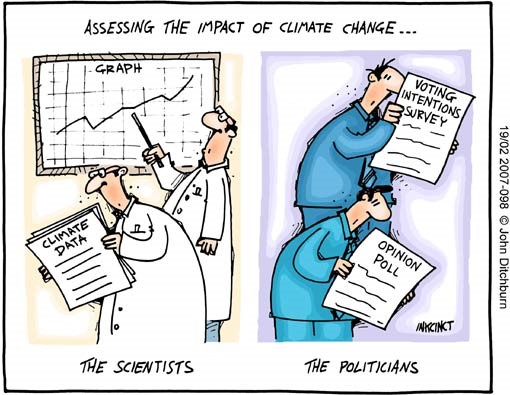
5.0 Reflection
Do you believe that the ETF (enhanced transparency framework) will bring more transparency in a country’s reporting of their GHG levels in their BTR (Biennial Transparency Report)?
Did you know that BTRs, NCs, BURs and BRs required so much data?
Does your country have a robust MRV in place for collecting and analysing climate change related data?

Notes
[1]The Convention divides countries into three main groups according to differing
commitments: Annex 1 Parties include the industrialized countries that were members of the OECD (Organisation for Economic Co-operation and Development) in 1992, plus countries with economies in transition (the EIT Parties), including the Russian Federation, the Baltic States, and several Central and Eastern European State
Annex II Parties consist of the OECD members of Annex I, but not
the EIT Parties.
[2] Non-Annex 1 Parties are mostly developing countries, 49 of which are classified as least developed countries (LDCs)
Bibliography
Decision 18/CMA.1. Modalities procedures and guidelines for the transparency framework for action and support referred to in Article 13 of the Paris Agreement.
Decision 5/CMA.3. Guidance for operationalizing the modalities, procedures and guidelines for the enhanced transparency framework referred to in Article 13 of the Paris Agreement.
Global Environment Facility, (GEF), (2020), Information note on the financing of biennial transparency reports for developing countries parties to the Paris Agreement
Kyoto Protocol to the United Nations Framework Convention on Climate Change, 1997.
Paris Agreement,2015.
United Nations Framework Convention on Climate Change. 1992.
UNFCCC, (2014), Handbook on measurement, reporting and verification for developing countries parties, Bonn, Germany.
UNFCCC, FAQ’s on the operationalization of the Enhanced Transparency Framework.
UNFCCC,(2022), Reference Manual for the Enhanced Transparency Framework under
the Paris Agreement, Understanding the enhanced transparency framework
and its linkages.
